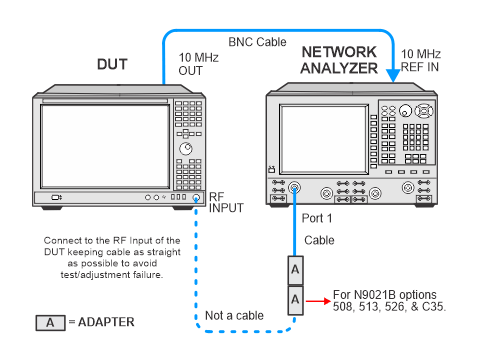IF Frequency Response Adjustment
This adjustment applies to the following models and options:
And with options:
- B25, B40, B85, B1A, B1X
-
MPB
|

|
N9030B PXA models with frequency options 544 or 550 and without bandwidth options B2X or B5X have the option to run the "classic" alternate adjustment using a PSG-D signal generator. These "classic" adjustments are run from the Utilities Test Plan. For more information, click here.
The solution used on this topic page with the PNA-X network analyzer is the preferred solution for all N9030B PXA models with frequency options > 526.
|
The goal of this adjustment is to generate corrections for the IF band shape. If the Analyzer has Option MPB (Preselector Bypass) then all the IF paths (Option B25, B40) will have corrections generated for Bands 1 through 6. Option MPB is recommended because the YTF is a tunable bandpass filter with a nominal bandwidth of 30 MHz to 50 MHz. The bandwidth of the YTF will band limit the IF Frequency Response. To summarize the Option MPB dependency:
|
Option MPB installed:
|
Option B25: Adjust for Bands 1, 2, 3, 4, 5, 6
Option B40: Adjust for Bands 1, 2, 3, 4, 5, 6
(N9021B will also adjust for band 0)
|
|
Option MPB NOT installed:
|
Option B25: Do not adjust
Option B40: Do not adjust
Option B1X: Adjust for Band 0 only
N9021B: Adjust for Band 0 only
|
In this adjustment a –10.00 dBm signal is applied to the signal analyzer. A reference amplitude is taken at the IF Center Frequency. The Source Frequency is then changed to a series of offset frequencies within the span of the IF. At each offset frequency the input amplitude is maintained at –10.00 dBm, and the signal amplitude is measured by the signal analyzer. The offset amplitude is subtracted from the reference amplitude. The resulting envelope created by all the offset amplitudes is the uncorrected IF Frequency Response.
The IF Response will be biased by the slope of the RF flatness across the IF bandwidth. The relative RF flatness must be added to the IF response. This will be done by interpolating the RF Flatness corrections contained in the cal file. The interpolated response will be zero at the center of the IF.
For MPB Bands 1 through 6 generally one set of corrections will be stored in memory for each band and each IF path (B25, B40). The corrections will be generated by averaging the response from several measurements across the band. Option B40 Band 3 will store multiple polynomials across the entire band corrections due to RF flatness ripple issues.
Click here for troubleshooting.
Required Test Equipment
|
Test Equipment
|
Recommended Model Number
|
|
Network Analyzer1, 2
|
N5247B
|
|
Cable, BNC (m) to BNC (m)
|
8120-1840
|
|
Cable, 2.4 mm (f) to 2.4 mm (m)
|
8121-2065 (or equivalent)
|
|
Adapter, 2.4 mm (f) to 2.4 mm (f)
|
11900B (or equivalent)
|
|
Adapter, Type-N (m) to 2.4 mm (m)
|
11903A
|
|
Adapter, 2.4 mm (m) to 3.5 mm (f)
|
11901C
|
-
A calibration must be performed on the network analyzer prior to running the adjustment (see below).
-
PNA preference setting recommendation: Unselect Power: Force RF Power Off at the end of the sweep
|
Network Analyzer Calibration Procedure
The network analyzer used in this adjustment must be calibrated prior to running the adjustment. The calibration will need to be repeated once every three days or if the connectors or cables have been disturbed. If it's been within the three day time frame and the connectors and cables have not been disturbed, then the network analyzer calibration is not necessary and you may proceed with the adjustment.
For a list of required equipment and calibration instructions to perform the network analyzer calibration, refer to Network Analyzer Freq Sweep Calibration.
Connection Setups
|

|
In the following setups, cables are designated as solid lines and direct connections are designated as dashed lines.
|




